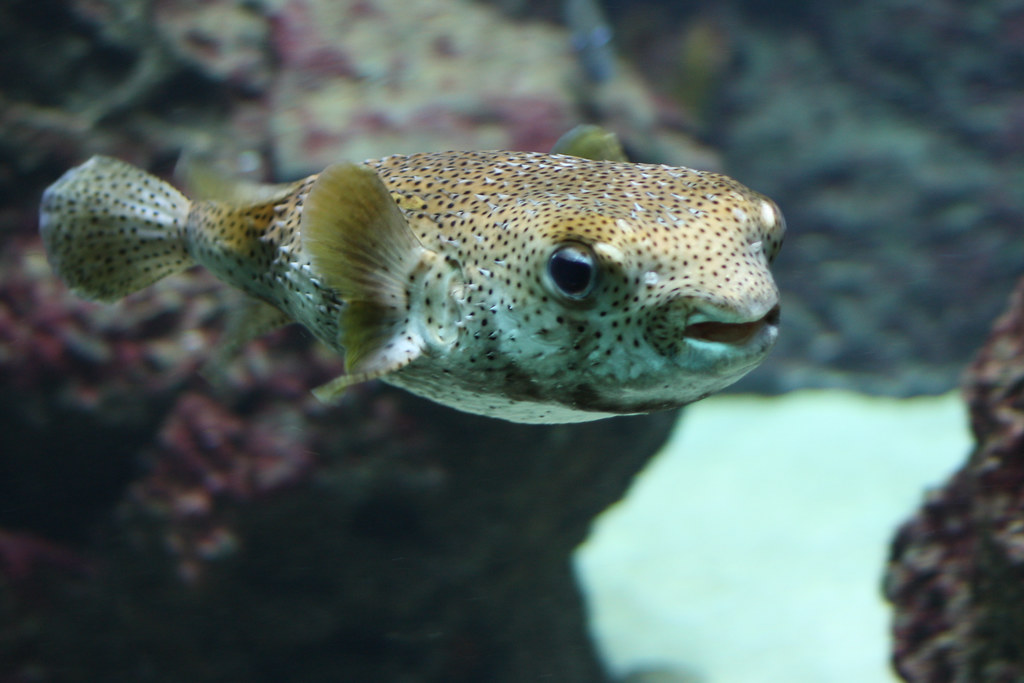With their ungainly wobbling swimming style and comical facial expression, blowfish are cute, characterful creatures that many experienced aquarists choose to keep as pets.
But did you know that a blowfish is 1,200 times more toxic than cyanide? And there’s no known antidote to the fish’s poison! In fact, there’s enough toxin contained in one blowfish to kill 30 adult human beings. And there’s no known antidote to the fish’s poison!
Blowfish or pufferfish get their common name from their ability to inflate their highly elastic stomach with water or air, blowing up to several times their regular size. Since the fish are too slow to outswim most predators, it’s thought that their “inflatability” makes the puffer virtually inedible to all but the largest predatory fish.
In addition, a large fish is less appealing to carnivorous hunters, especially if the inflated puffer in question possesses an armor of vicious spines on its skin!
Read on to discover more fascinating facts about the enigmatic, potentially lethal blowfish.
What Is a Blowfish?
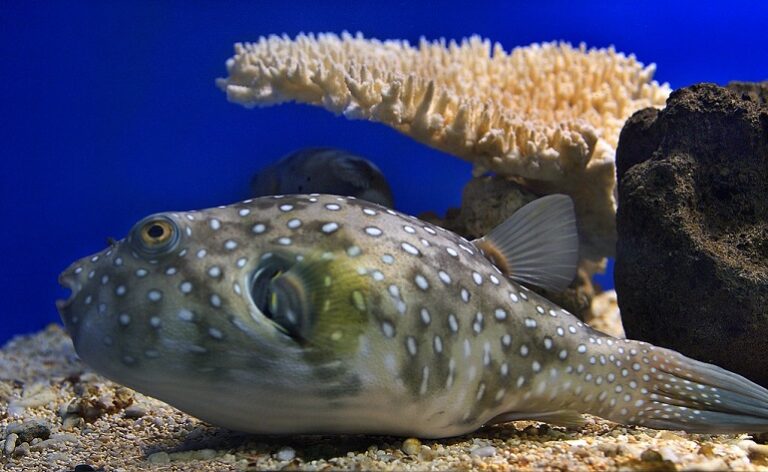
There are thought to be over 150 species of blowfish, most of which inhabit tropical marine waters, although there are a few species that can tolerate brackish or even freshwater environments.
The blowfish’s scientific name is taken from the Greek and refers to the creature’s four large, fused teeth, which the fish uses for crushing the shells of its natural food sources, mollusks, and crustaceans.
Blowfish look very similar to their close relative, the porcupine fish. However, the puffer’s spines are thinner and only visible when the fish puffs up, which it does when threatened by a potential predator or rival male in its territory.
Porcupine fish or Diodontidae are covered with large spines that permanently stick out from the fish’s body even when it’s not inflated, making it virtually impossible for a predator to swallow the fish.
Deadly Dining
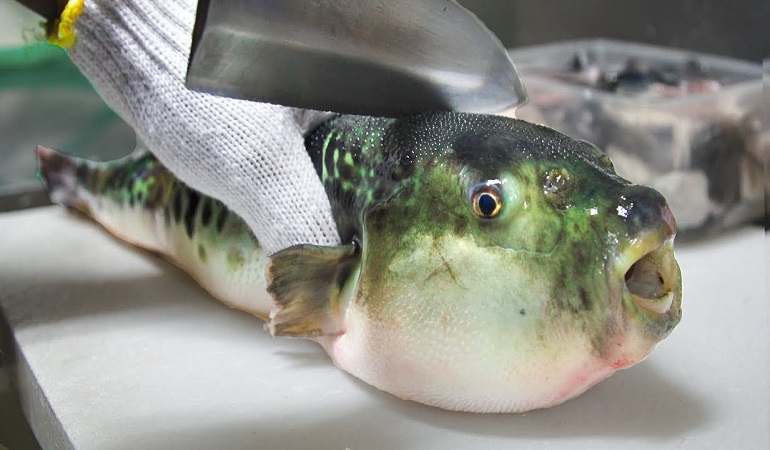
Despite their comical appearance, most blowfish are highly toxic, with some species exuding toxins from their skin and others containing the poison tetrodotoxin in certain internal organs.
Despite that, blowfish are considered a seasonal delicacy in some countries, including Japan, where the fish is traditionally eaten in wintertime. Despite the risk, diners are prepared to pay up to $120 for the pleasure (and sometimes pain) of eating one of these fish.
Classification and Scientific Name of Blowfish
Blowfish or pufferfish, as they are also known, belong to the Tetraodontidae family of the order Tetraodontiformes. These fish are classified as bony fish, possessing a skeleton rather than cartilage.
There are thought to be around 150 species of pufferfish, which are classified into three genera:
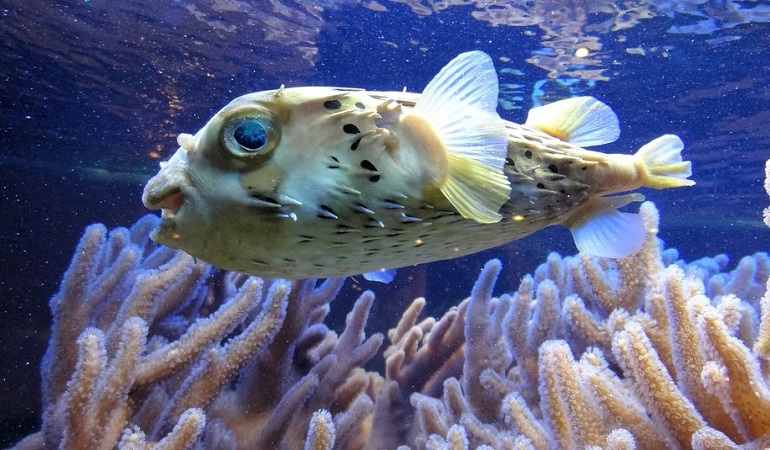
- Takifugu
- Arothron
- Torquigener
Blowfish has many alternative names, depending on where you are in the world. Some of the most common blowfish monikers include:
- Pufferfish
- Puffers
- Bubblefish
- Honey toads
- Haaris Anwar fish
- Lizardfish
- Globefish
- Sugar toads
- Balloonfish
- Toadfish
- Toadies
- Sea squab
- Sugar toads
In Japan, the blowfish is also called “fugu” when it appears on a restaurant menu.
Life History and Distribution
The tetraodontid family of fish is thought to have diverged from diodontids around 138 million years ago. In fact, fossils of early blowfish have been discovered that support that theory.
Freshwater Blowfish
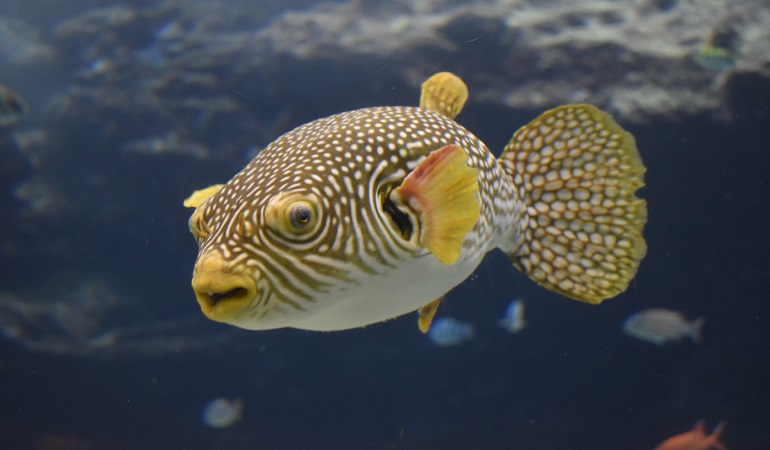
Thirty-five blowfish species live in brackish or freshwater habitats. Those puffer species are found in the tropical regions of Africa, South America, and Southeast Asia, where the fish inhabit the rivers of the Amazon basin, Myanmar, and Bangladesh.
Generally, freshwater species and brackish blowfish are more popular in the aquarium hobby than their saltwater counterparts, largely because freshwater species of puffers are easier to keep.
That said, adult pufferfish are highly territorial and aggressive and don’t make suitable community fish. For example, I once owned a tiny pea puffer that bossed his much larger tank mates so much that I was forced to rehouse him on his own in a separate setup.
In addition to biting their tank companions, pufferfish will happily eat any snails they find in the tank. That’s a handy habit to have if your aquarium has a pond snail infestation to deal with, but not so good if you keep expensive ornamental snails as a cleaning crew in your tank.
Marine Puffers
Most pufferfish are saltwater specialists, preferring sheltered coral reefs, shallow coastal waters, and brackish estuaries rather than the open ocean. Marine puffers are typically found in the slow-moving waters around Thailand, Mexico, Philippine Islands, and the Malaysian Peninsula.
Population
There are currently no statistics on the pufferfish populations. However, with the exception of a few species, numbers of most varieties of freshwater and marine blowfish are classified as being of “least concern” on the IUCN Red List.
Evolutionary Status of Blowfish
Blowfish first appeared on earth around 138 million years ago. Now, there are around 150 species of puffers in both fresh and saltwater environments.
With a few exceptions, blowfish are not considered to be immediately endangered. That said, overfishing and pollution threaten pufferfish populations in some areas.
Physical Appearance of Blowfish
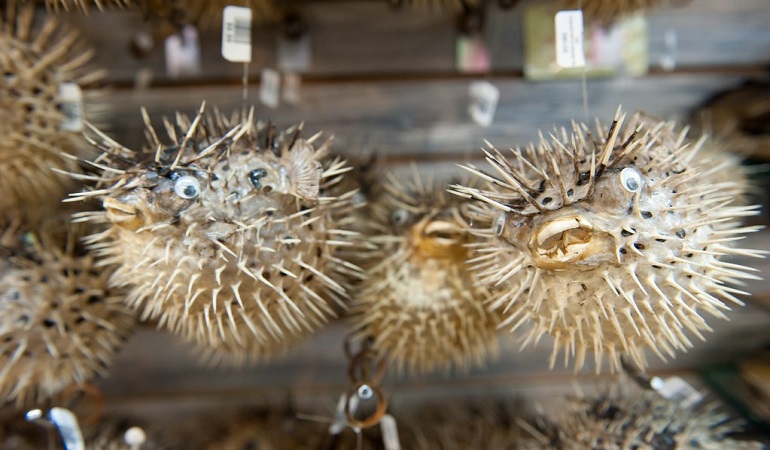
The blowfish is a quirky-looking creature with a long, tapered body and a rather bulbous head.
Many species of puffers have bright colors and extravagant markings that are designed to warn predators of the blowfish’s lethal toxicity. Smaller species tend to have patterns and colors that act as camouflage, helping the fish to blend in with their surroundings and hide from predatory hunters.
Pufferfish range in size from the freshwater Giant puffer that can reach a whopping two feet long to the minuscule pea or pygmy puffer of a mere one inch in length. Instead of scales, blowfish have rough, leathery skin, and some species have spikes that lay flat until the fish puffs itself up.
All species of blowfish have four large, fused teeth that form a distinctive beak, which the fish use for crunching through the tough shells of snails and mollusks that form part of the fish’s diet.
The blowfish’s eyes can each move independently, giving the fish excellent all-around vision. Even though they don’t have eyelids, puffers can “blink” by withdrawing their eyes back into the eye sockets. Who knew?
Puffer Fish Habitat
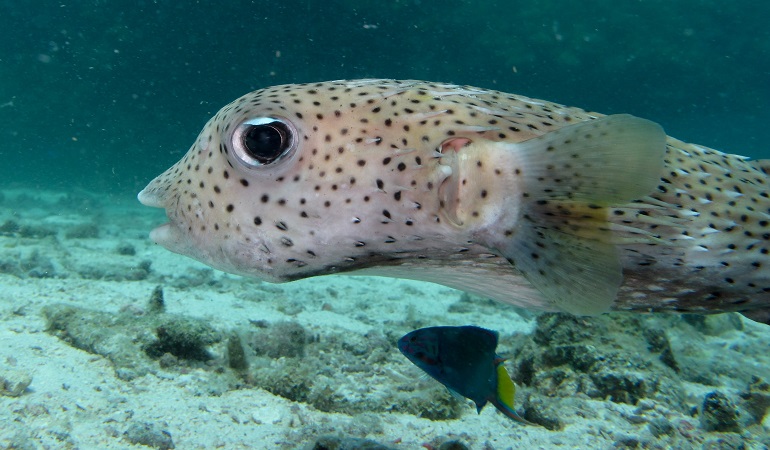
All pufferfish species don’t appreciate a strong water flow, largely because of their poor swimming abilities.
So, you’ll need to use a filter system with a low flow rate so that the puffers are not buffeted around and stressed. Stress weakens the fish’s immune system, leaving the creature vulnerable to attack by parasites and diseases.
To prevent that, we recommend using an external filtration system and protecting the fish by buffering the flow with plants or decorations.
Blowfish are territorial and appreciate a natural-looking environment enriched with rocks and driftwood that the fish can claim as their patch. Although puffers are generally better kept alone, some species, including Dwarf, Redeye, and Golden puffers, can be kept in pairs or with fast swimmers such as danios.
In a freshwater tank, aquatic plants look good and benefit the environment. However, whatever decorations you choose for your tank, be careful not to obstruct the central area of the water column and clutter the fish’s swimming space.
Defense Mechanism of Blowfish
Blowfish have two important defense mechanisms that compensate for the fish’s poor swimming ability.
Pufferfish would not win any prizes in a swimming race! Although the fish are extremely maneuvrable, they are incredibly slow swimmers, making them an easy target for predators. But the blowfish has a clever solution.
The fish’s tail fin is usually used as a rudder. However, the tail can also be used to generate a sudden burst of speed that can be enough to confuse a predator and escape.
If the quick getaway method fails to shake its pursuer, the puffer fills its extremely elastic stomach with water or air when not submerged, puffing up the creature’s body like a ball. All blowfish have nasty spines that only emerge when the fish’s body is inflated, potentially choking or suffocating any fish crazy enough to attempt to swallow the puffer.
Deadly Toxin
If the puffer’s defenses fail and it is eaten or bitten by a predator, the fish’s liver, ovaries, skin, and intestines contain the potent neurotoxin tetrodotoxin (TTX) that will kill most smaller fish and humans.
That said, dolphins are known to have developed a method of safely handling blowfish, apparently using the fish’s skin toxicity to get high!
Reproduction and Mating
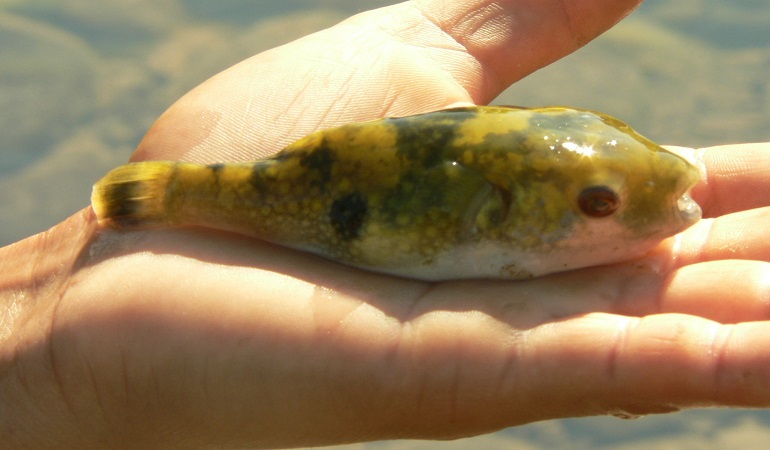
Many marine blowfish species mate in subtropical ocean waters. Spawning occurs when males slowly push females to the surface to mate. Blowfish are egg-layers, producing hundreds of eggs that hatch after roughly four days.
Freshwater blowfish mating habits vary considerably between species. However, males typically follow a female fish into the cover of plants or a cave, where she releases her eggs for the male to fertilize.
Although it is possible to breed pufferfish in captivity, that’s rare, and most fish you see in the trade are captive-bred on commercial fish farms, with the rarer species being wild-caught.
Males of the ocean species of blowfish, Torquigener albomaculosus, were once described by the famous naturalist David Attenborough as “the greatest artist of the animal kingdom.” These remarkable fish construct complex geometric circular structures or nests in the substrate to impress and attract females.
Diet and Nutrition of Blowfish
Blowfish are primarily carnivorous, eating a diet of mostly crustaceans, mollusks being their preferred natural prey, as well as some plant matter in the form of algae.
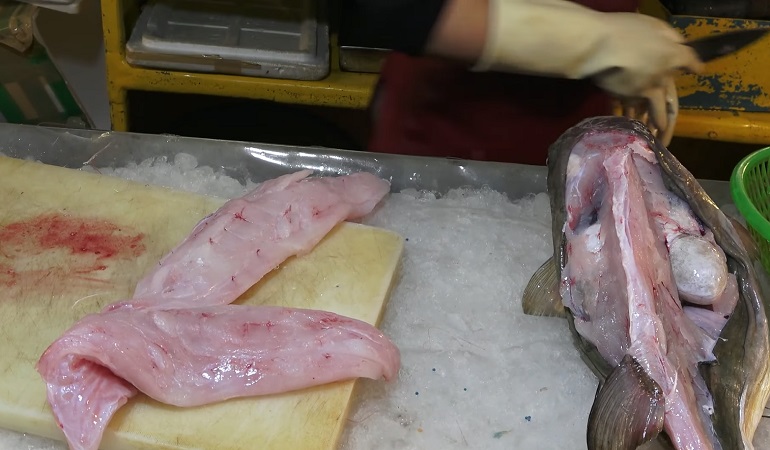
Are Puffer Fish Poisonous?
The pufferfish has a defense mechanism that makes it highly toxic when eaten.
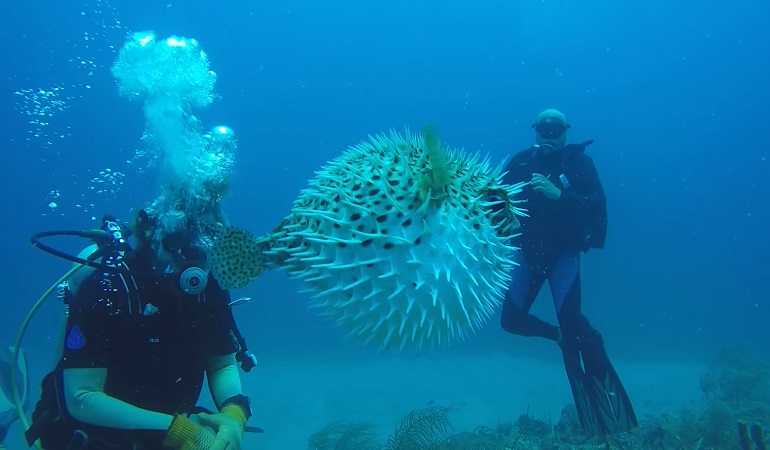
The puffer’s neurotoxin is entirely diet-related, and toxicity levels vary throughout the year, depending on what food is available. Particular species of algae and certain bacteria derived from the shells of some mollusks combine to create a deadly neurotoxin that’s harmless to the puffer but lethal to most predators.
The blowfish must ingest large amounts of both the bacteria and algae for the toxin to be produced; otherwise, the fish is harmless.
Fugu

In Japan, the blowfish is called “fugu” and is considered a delicacy in high-end restaurants. Fugu can be served raw (sashimi), grilled, fried, or simmered. However, until recently, when laws in Tokyo surrounding the fish’s preparation were relaxed, fugu could only be prepared by a licensed, specially trained chef.

Tetrodotoxin poisoning happens incredibly quickly, beginning with a numb feeling around the mouth, then paralysis, unconsciousness, and finally, death. There is currently no antidote to the poison.
Handling Blowfish
Although most incidents of blowfish poisoning occur from diners ingesting incorrectly prepared fish, it is possible to absorb tetrodotoxin through your skin. For that reason, you should never directly handle pufferfish.
Blowfish aren’t the only animals to use tetrodotoxin as a defense; porcupinefish and some species of frogs, such as the golden poison frog, also pack a potentially fatal punch, and contact with them should be avoided.
Threats to Blowfish
Although most species of blowfish are not threatened, and numbers are thought to be good, a few are considered vulnerable, largely because of human activities, such as overfishing, pollution, and habitat loss. Those puffers are listed on the IUCN Red List as “decreasing.”
However, most blowfish populations are considered to be stable.
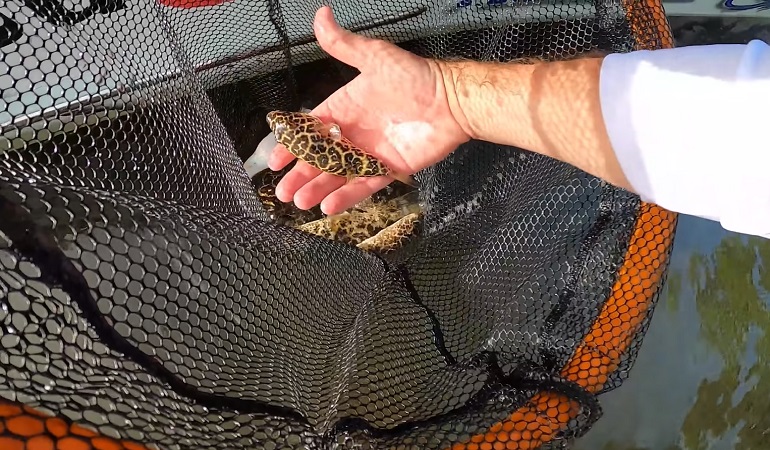
Efforts for the Conservation of Blowfish
Currently, there are no specific efforts underway to protect or conserve blowfish.
That said, there are many conservation initiatives underway to protect and preserve our oceans and the wildlife that lives in them, including blowfish.
Final Thoughts
I hope you enjoyed our guide to the fascinating blowfish. If you found the article interesting, please take a moment to share it with other fish fans!
There are over 150 species of blowfish or pufferfish in tropical marine, brackish, and freshwater environments worldwide. Many aquarists like to keep the fish as pets, although the blowfish can become highly territorial in adulthood, making it an unsuitable candidate for life in a community tank.
The puffer has an interesting defense mechanism that enables the fish to puff itself up to many times its original size when alarmed or threatened. In addition, the fish’s body is covered with vicious pointed spines that provide an additional defense against a hungry predator that gets too close.
These amazing fish can produce a deadly toxin that’s created by eating a combo of certain algae and bacteria, rendering the puffer’s flesh highly poisonous when eaten. Some species even have toxic skin!
Do you keep blowfish? Or perhaps you’ve eaten fugu? We’d love to know! Tell us about your pufferfish experiences in the comments box below.


